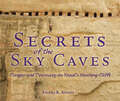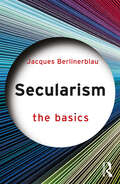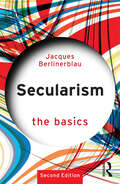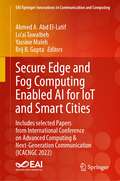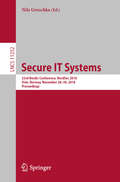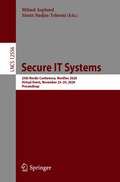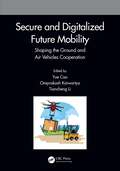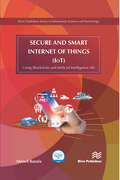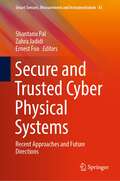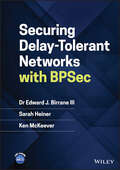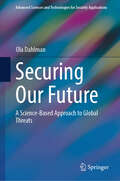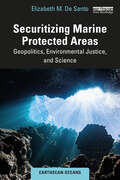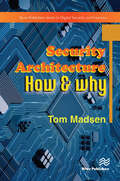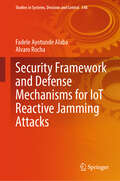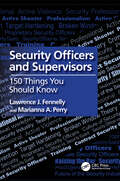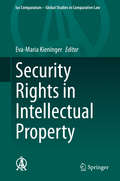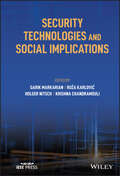- Table View
- List View
Secrets of the Oak Woodlands: Plants and Animals Among California's Oaks
by Kate MarianchildA Californian may vacation in Yosemite, Big Sur, or Death Valley, but many of us come home to an oak woodland. Yet, while common, oak woodlands are anything but ordinary. In a book rich in illustration and suffused with wonder, author Kate Marianchild combines extensive research and years of personal experience to explore some of the marvelous plants and animals that the oak woodlands nurture. Acorn woodpeckers unite in marriages of up to ten mates and raise their young cooperatively. Ground squirrels roll in rattlesnake skins to hide their scent from hungry snakes. Manzanita's rust-colored, paper-thin bark peels away in time for the summer solstice, exposing sinuous contours that are cool to the touch even on the hottest day. Conveying up-to-the-minute scientific findings with a storyteller's skill, Marianchild introduces us to a host of remarkable creatures in a world close by, a world that “rustles, hums, and sings with the sounds of wild things.”
Secrets of the Sea: The Story of Jeanne Power, Revolutionary Marine Scientist
by Evan GriffithThe curiosity, drive, and perseverance of the nineteenth-century woman scientist who pioneered the use of aquariums to study ocean life are celebrated in this gorgeous, empowering picture book.How did a nineteenth-century dressmaker revolutionize science? Jeanne Power was creative: she wanted to learn about the creatures that swim beneath the ocean waves, so she built glass tanks and changed the way we study underwater life forever. Jeanne Power was groundbreaking: she solved mysteries of sea animals and published her findings at a time when few of women&’s contributions to science were acknowledged. Jeanne Power was persistent: when records of her research were lost, she set to work repeating her studies. And when men tried to take credit for her achievements, she stood firm and insisted on the recognition due to her.Jeanne Power was inspiring, and the legacy of this pioneering marine scientist lives on in every aquarium.
Secrets of the Seasons: Orbiting the Sun in Our Backyard
by Kathleen Weidner ZoehfeldThe family from Secrets of the Garden are back in a new book about backyard science that explains why the seasons change.Alice and her friend Zack explore the reasons for the seasons. Alice's narrative is all about noticing the changes as fall turns into winter, spring, and then summer. She explains how the earth's yearlong journey around the sun, combined with the tilt in the earth's axis, makes the seasons happen. Alice's text is clear and simple, and experiential. Two very helpful—and very funny—chickens give more science details and further explanation through charts, diagrams, and sidebars. Packed with sensory details, humor, and solid science, this book makes a complicated concept completely clear for young readers—and also for the many parents who struggle to answer their kids' questions! "Several adults of my acquaintance . . . would find Secrets of the Seasons to be an eye-popping revelation." —John Lithgow, The New York Times Book Review
Secrets of the Sixth Edition
by Randall HedtkeDarwin's On the Origin of the Species was originally released in 1859, and by 1872, the sixth and last edition was published, becoming the defining text for evolutionists. This controversial work has become the foundation of modern textbooks for scientific studies in origins, though Darwin himself expressed deep doubts about his own speculations and suppositions. Secrets of the Sixth Editionby Randall Hedtke exposes the critical flaws of this landmark book by using Darwin's own words against him. Provides an examination of Darwin's research and the faulty basis of his scientific writings Filled with extensive documentation looking at the fatal flaws in Darwin's assumptions Addresses strategies for possible changes to curriculum to address weaknesses in the evolutionary hypothesis. Take an insightful look at Darwin's work and its inaccuracies from a fresh and logical perspective. You will discover the often ignored reasoning behind his own abandonment of some of the core mechanisms of evolution later in his life, though they remain unchallenged pillars of unquestioning science today. This informative and easy-to-read study boldly declares the powerful truth that only biblical creation can explain.
Secrets of the Sky Caves: Danger and Discovery on Nepal's Mustang Cliffs
by Sandra K AthansWhat's more dangerous than scaling Mount Everest? For mountaineer Pete Athans, the answer lies in the ancient kingdom of Mustang, a remote part of the Asian nation of Nepal. Long-abandoned caves built high into steep cliffs contain amazing treasures—and pose incredible dangers. Reaching these "sky caves" safely takes guts, smarts, and luck. And then there's the question of what to do with a two-thousand-year-old human skull. . . From 2007 to 2012, Pete explored Mustang's sky caves with a team that included scientists, mountain climbers, and even two children. They found mummies, murals, manuscripts, and other priceless artifacts. Follow Pete on his dangerous trips to the sky caves and discover the secrets the caves revealed.
Secrets of the Snout: The Dog’s Incredible Nose
by Frank RosellDogs and humans have worked side by side for thousands of years, and over the millennia we’ve come to depend upon our pooches as hunters, protectors, and faithful companions. But when it comes to the extraordinary quality of man’s best friend which we rely on most, the winner is clear—by a nose. In Secrets of the Snout, Frank Rosell blends storytelling and science as he sniffs out the myriad ways in which dogs have been trained to employe their incredible olfactory skills, from sussing out cancer and narcotics to locating endangered and invasive species, as well as missing persons (and golf balls). With 300 million receptors to our mere 5 million, a dog’s nose is estimated to be between 100,000 and 100 million times more sensitive than a human’s. No wonder, then, that our nasally inferior species has sought to unleash the prodigious power of canine shnozzes. Rosell here takes us for a walk with a pack of superhero sniffers including Tutta, a dog with a fine nose for fine wine; the pet-finder pooch AJ; search-and-rescue dog Barry; the hunting dog Balder; the police dogs Rasko and Trixxi; the warfare dog Lisa; the cancer detection dog Jack; Tucker, who scents floating killer whale feces; and even Elvis, who can smell when you’re ovulating. With each dog, Rosell turns his nose to the evolution of the unique olfactory systems involved, which odors dogs detect, and how they do it. A celebration of how the canine sense for scents works—and works for us—Secrets of the Snout will have dog lovers, trainers, and researchers alike all howling with delight. Exploring this most pointed of canine wonders, Rosell reveals the often surprising ways in which dogs are bettering our world, one nose at a time.
Secrets to Success for Science Teachers
by Ellen Kottler Victoria B. CostaProvides teachers with practical ideas and strategies for promoting inquiry, building literacy, implementing technology, and achieving meaningful instruction in the science classroom.
Secrets to Success for Science Teachers
by Ellen Kottler Victoria Brookhart CostaThis easy-to-read guide provides new and seasoned teachers with practical ideas, strategies, and insights to help address essential topics in effective science teaching, including emphasizing inquiry, building literacy, implementing technology, using a wide variety of science resources, and maintaining student safety.
Secularism: The Basics (The Basics)
by Jacques BerlinerblauSecularism: The Basics is a concise and engaging introduction to confusing and contradictory public discussions of secularism across the globe. “Secularism” must be the most confused and convoluted term in the entire global political lexicon. From New York to Paris, to Istanbul, to Addis Ababa, to New Delhi, to Montevideo, there are countless examples of politicians, religious leaders and journalists, invoking the S-word in heated debates about public education, gender, sex, national symbols, and artistic freedom. In this lively and lucid book, Jacques Berlinerblau addresses why secularism is defined in so many ways and why it so ignites people’s passions. In so doing, he explores the following important questions: What does secularism mean? Why should we care about this idea? What are the different types of secularism and what are their histories? What are the basic principles of political secularisms? Why are secularism and Atheism often confused? What is the relationship between secularism and LGBTQ rights? What opposition are secularisms up against? What does the future hold for a concept millennia in the making, but only really operationalized in the twentieth century? With a glossary of key terms, case studies, informative tables, and suggestions for further reading throughout, the book considers key philosophical, religious, anti-religious, post-modern and post-colonial arguments around secularism. This book is an ideal starting point for anyone seeking a readable introduction to the often-conflicting interpretations of one of our era’s most complex and controversial ideas.
Secularism: The Basics (The Basics)
by Jacques BerlinerblauSecularism: The Basics is a concise and engaging introduction to confusing and contradictory public discussions of secularism across the globe. In this lively and lucid book, Jacques Berlinerblau addresses why secularism is defined in so many ways and why it so ignites people’s passions. In so doing, he explores the following important questions: What does secularism mean? Why should we care about this idea? What are the different types of secularism and what are their histories? What are the basic principles of political secularisms? Why are secularism and Atheism often confused? What is the relationship between secularism and LGBTQ rights? What opposition are secularisms up against? What does the future hold for a concept millennia in the making, but only really operationalized in the last century and a half? This thoroughly updated new edition includes two new chapters on African Secularisms and the importance of Mexico in the history of political secularism. With a glossary of key terms, new and updated case studies throughout, informative tables, and suggestions for further reading, the book considers key philosophical, religious, anti-religious, and post-colonial arguments around secularism. This book continues to be an ideal starting point for anyone seeking a readable introduction to the often-conflicting interpretations of one of our era’s most complex and controversial ideas.
Secure Edge and Fog Computing Enabled AI for IoT and Smart Cities: Includes selected Papers from International Conference on Advanced Computing & Next-Generation Communication (ICACNGC 2022) (EAI/Springer Innovations in Communication and Computing)
by Brij B. Gupta Yassine Maleh Lo’ai Tawalbeh Ahmed A. Abd El-LatifThis book gathers recent research in security and privacy to discuss, evaluate, and improve the novel approaches of data protection in IoT and edge and fog computing. The primary focus of the book addresses security mechanisms in IoT and edge/ fog computing, advanced secure deployments for large scaled edge/ fog computing, and new efficient data security strategy of IoT and edge/ fog computing. The book lays a foundation of the core concepts and principles of IoT and 5G security, walking the reader through the fundamental ideas. This book is aimed at researchers, graduate students, and engineers in the fields of secure IoT and edge/ fog computing. The book also presents selected papers from International Conference on Advanced Computing & Next-Generation Communication (ICACNGC 2022).
Secure IT Systems: 23rd Nordic Conference, NordSec 2018, Oslo, Norway, November 28-30, 2018, Proceedings (Lecture Notes in Computer Science #11252)
by Nils GruschkaThis book constitutes the refereed proceedings on the 23rd Nordic Conference on Secure IT Systems, NordSec 2018, held in Oslo, Norway, in November 2018.The 29 full papers presented in this volume were carefully reviewed and selected from 81 submissions. They are organized in topical sections named: privacy; cryptography; network and cloud security; cyber security and malware; and security for software and software development.
Secure IT Systems: 25th Nordic Conference, NordSec 2020, Virtual Event, November 23–24, 2020, Proceedings (Lecture Notes in Computer Science #12556)
by Simin Nadjm-Tehrani Mikael AsplundThis book constitutes the refereed proceedings of the 25th Nordic Conference on Secure IT Systems, NordSec 2020, which was organized by Linköping University, Sweden, and held online during November 23-24, 2020.The 15 papers presented in this volume were carefully reviewed and selected from 45 submissions. They were organized in topical sections named: malware and attacks; formal analysis; applied cryptography; security mechanisms and training; and applications and privacy.
Secure and Digitalized Future Mobility: Shaping the Ground and Air Vehicles Cooperation
by Omprakash Kaiwartya Yue Cao Tiancheng LiThis book discusses the recent advanced technologies in Intelligent Transportation Systems (ITS), with a view on how Unmanned Aerial Vehicles (UAVs) cooperate with future vehicles. ITS technologies aim to achieve traffic efficiency and advance transportation safety and mobility. Known as aircrafts without onboard human operators, UAVs are used across the world for civilian, commercial, as well as military applications. Common deployment include policing and surveillance, product deliveries, aerial photography, agriculture, and drone racing. As the air-ground cooperation enables more diverse usage, this book addresses the holistic aspects of the recent advanced technologies in ITS, including Information and Communication Technologies (ICT), cyber security, and service management from principle and engineering practice aspects. This is achieved by providing in-depth study on several major topics in the fields of telecommunications, transport services, cyber security, and so on. The book will serve as a useful text for transportation, energy, and ICT societies from both academia and industrial sectors. Its broad scope of introductory knowledge, technical reviews, discussions, and technology advances will also benefit potential authors.
Secure and Smart Internet of Things (IoT): Using Blockchain and AI
by Ahmed BanafaBy 2020, experts forecast that up to 28 billion devices will be connected to the Internet, with only one third of them being computers, smartphones, smartwatches, and tablets. The remaining two thirds will be other “devices” – sensors, terminals, household appliances, thermostats, televisions, automobiles, production machinery, urban infrastructure and many other “things”, which traditionally have not been Internet enabled.This “Internet of Things” (IoT) represents a remarkable transformation of the way in which our world will soon interact. Much like the World Wide Web connected computers to networks, and the next evolution mobile devices connected people to the Internet and other people, IoT looks poised to interconnect devices, people, environments, virtual objects and machines in ways that only science fiction writers could have imagined. In a nutshell the Internet of Things (IoT) is the convergence of connecting people, things, data and processes; it is transforming our life, business and everything in between. Secure and Smart IoT explores many aspects of the Internet of Things and explains many of the complicated principles of IoT and the new advancements in IoT including using Fog Computing, AI and Blockchain technology.
Secure and Trusted Cyber Physical Systems: Recent Approaches and Future Directions (Smart Sensors, Measurement and Instrumentation #43)
by Ernest Foo Shantanu Pal Zahra JadidiThis book highlights the latest design and development of security issues and various defences to construct safe, secure and trusted Cyber-Physical Systems (CPS). In addition, the book presents a detailed analysis of the recent approaches to security solutions and future research directions for large-scale CPS, including its various challenges and significant security requirements. Furthermore, the book provides practical guidance on delivering robust, privacy, and trust-aware CPS at scale. Finally, the book presents a holistic insight into IoT technologies, particularly its latest development in strategic applications in mission-critical systems, including large-scale Industrial IoT, Industry 4.0, and Industrial Control Systems. As such, the book offers an essential reference guide about the latest design and development in CPS for students, engineers, designers, and professional developers.
Securing Delay-Tolerant Networks with BPSec
by Edward J. Birrane III Sarah Heiner Ken McKeeverSecuring Delay-Tolerant Networks with BPSec One-stop reference on how to secure a Delay-Tolerant Network (DTN), written by experienced industry insiders Securing Delay-Tolerant Networks with BPSec answers the question, “How can delay-tolerant networks be secured when operating in environments that would otherwise break many of the common security approaches used on the terrestrial Internet today?” The text is composed of three sections: (1) security considerations for delay-tolerant networks, (2) the design, implementation, and customization of the BPSec protocol, and (3) how this protocol can be applied, combined with other security protocols, and deployed in emerging network environments. The text includes pragmatic considerations for deploying BPSec in both regular and delay-tolerant networks. It also features a tutorial on how to achieve several important security outcomes with a combination of security protocols, BPSec included. Overall, it covers best practices for common security functions, clearly showing designers how to prevent network architecture from being over-constrained by traditional security approaches. Written by the lead author and originator of the BPSec protocol specification, Securing Delay-Tolerant Networks (DTNs) with BPSec includes information on: The gap between cryptography and network security, how security requirements constrain network architectures, and why we need something different DTN stressing conditions, covering intermittent connectivity, congested paths, partitioned topologies, limited link state, and multiple administrative controls Securing the terrestrial internet, involving a layered approach to security, the impact of protocol design on security services, and securing the internetworking and transport layers A delay-tolerant security architecture, including desirable properties of a DTN secure protocol, fine-grained security services, and protocol augmentation Securing Delay-Tolerant Networks (DTNs) with BPSec is a one-stop reference on the subject for any professional operationally deploying BP who must use BPSec for its security, including software technical leads, software developers, space flight mission leaders, network operators, and technology and product development leaders in general.
Securing Our Future: A Science-Based Approach to Global Threats (Advanced Sciences and Technologies for Security Applications)
by Ola DahlmanIn an era marked by escalating global crises—climate change, cyber threats, pandemics, and nuclear weapons proliferation—this book introduces a science-based approach to security and global threats. It underscores the necessity of interdisciplinary science and technology to ensure that decisions and actions are grounded in knowledge. This vision seeks to inspire, promote, and facilitate collaboration across all sectors of global society. Building resilient societies and effectively addressing global threats will require substantial resources. Can we afford to save the Earth? Can we afford not to? Four Key Elements: A Science-Based Approach to Security and Global Threats: The book is structured around two key chapters: an opening chapter that outlines this new vision, and a concluding chapter that reflects on how to translate that vision into actionable steps. Evolution of Earth and Society: A review of the development of our planet leading to modern society, with a discussion on global demography and the economy—critical components of global security and resilience. Key Global Communities: An introduction to five global communities—states, cities, the business and scientific communities, and civil society. It examines how each can contribute to building security and assesses their vulnerabilities to various threats. Major Human-Created Threats: A discussion of five large-scale threats created by human activity or arising from human interaction with nature: global warming, natural disasters, biopandemics, nuclear weapons, and cyber threats. This book serves as a call for informed, collaborative action to address the pressing global challenges of our time.
Securitizing Marine Protected Areas: Geopolitics, Environmental Justice, and Science (Earthscan Oceans)
by Elizabeth M. De SantoThis book presents a novel examination of Marine Protected Areas within a security context, bridging science, policy, and geopolitics, and addressing the often-under-emphasized aspect of environmental justice.The book argues that Marine Protected Areas (MPAs) are not only a critical tool for protecting marine biodiversity in a changing climate, but they also play an important role at the intersection of geopolitics and environmental justice, and they provide a case study of environmental governance at the science-policy interface. The book takes an interdisciplinary and critical approach and builds on the author's two decades of experience working in this field. Geopolitically, it explores the ways in which MPAs provide footprints for influence and access to resources far from home for nations with overseas territories. MPAs also raise important issues connected to equity, environmental justice, and social justice, including access to resources and participation in environmental decision-making processes, key aspects for achieving long-term conservation goals. The book also demonstrates how MPAs are a critical lens for understanding how policy makers cope with scientific uncertainty, and the necessity of well-designed and precautionary science advisory processes. While the ecological contribution of MPAs is paramount, social issues and geopolitical considerations are often less obvious in the discourse underpinning MPAs, and the resulting tensions can undermine long-term conservation objectives. By applying the three lenses of geopolitics, environmental justice and science, this book provides key insights to help the international community moving past the 2030 biodiversity targets and beyond, towards a future of meaningful, equitable, and effective conservation approaches.This book will be of great interest to students and scholars of biodiversity conservation, marine studies, political geography, environmental governance, and science-policy studies. It will also be of interest to marine conservation governance professionals and policymakers.
Security Architecture – How & Why (River Publishers Series In Security And Digital Forensics Ser.)
by Tom MadsenSecurity Architecture, or Enterprise Information security architecture, as it was originally coined by Gartner back in 2006, has been applied to many things and different areas, making a concrete definition of Security architecture a difficult proposition. But having an architecture for the cyber security needs of an organization is important for many reasons, not least because having an architecture makes working with cyber security a much easier job, since we can now build on a, hopefully, solid foundation. Developing a security architecture is a daunting job, for almost anyone, and in a company that has not had a cyber security program implemented before, the job becomes even harder. The benefits of having a concrete cyber security architecture in place cannot be overstated! The challenge here is that a security architecture is not something that can stand alone, it absolutely must be aligned with the business in which is being implemented.This book emphasizes the importance, and the benefits, of having a security architecture in place. The book will be aligned with most of the sub frameworks in the general framework called SABSA, or Sherwood Applied Business Security Architecture. SABSA is comprised of several individual frameworks and there are several certifications that you can take in SABSA. Aside from getting a validation of your skills, SABSA as a framework focusses on aligning the Security Architecture with the business and its strategy. Each of the chapters in this book will be aligned with one or more of the components in SABSA, the components will be described along with the introduction to each of the chapters.
Security Framework and Defense Mechanisms for IoT Reactive Jamming Attacks (Studies in Systems, Decision and Control #548)
by Alvaro Rocha Fadele Ayotunde AlabaThis book digs into the important confluence of cybersecurity and big data, providing insights into the ever-changing environment of cyber threats and solutions to protect these enormous databases. In the modern digital era, large amounts of data have evolved into the vital organs of businesses, providing the impetus for decision-making, creativity, and a competitive edge. Cyberattacks pose a persistent danger to this important resource since they can result in data breaches, financial losses, and harm to an organization's brand. Features of particular interest include: a. Understanding the Threat Landscape: The book gives a complete review of the many different types of cyber threats that target big data, including data breaches, ransomware attacks, and insider threats. b. Analysing Real-World Case Studies: The purpose of this section is to provide the reader with useful insights into the strategies, methods, and processes that cyber adversaries use via the in-depth examination of real-world assaults on big data. c. Strategies for Risk Mitigation: This book provides a comprehensive and actionable approach to reducing the dangers of cyberattacks on large amounts of data. It encompasses a broad variety of tactics, including network protection, encoding, and access restrictions d. Emerging Technologies: This section introduces readers to cutting-edge technologies and best practices for securing large data. e. Compliance with Regulations: The book examines the regulatory environment that governs data protection and privacy, including the General Data Protection Regulation (GDPR), the California Consumer Privacy Act (CCPA), and industry-specific requirements. f. Trends of the Future: This book covers current trends and issues in cybersecurity and gives forward-looking views into the future of big data security. This is done in recognition that the cybersecurity environment is always shifting and developing. g. Contributors of Expertise: The book includes contributions from industry practitioners, data scientists, and cybersecurity specialists who have hands-on experience defending large data settings.
Security Manager's Guide to Disasters: Managing Through Emergencies, Violence, and Other Workplace Threats
by Anthony D. ManleyTerrorist or criminal attack, fire emergency, civil or geographic disruption, or major electrical failure recent years have witnessed an increase in the number of natural disasters and man-made events that have threatened the livelihoods of businesses and organizations worldwide. Security Manager‘s Guide to Disasters: Managing Through Emergencies,
Security Officers and Supervisors: 150 Things You Should Know
by Lawrence J. Fennelly Marianna A. PerrySecurity Officers and Supervisors: 150 Things You Should Know presents an array of relevant topics, including addressing “Tips of the Trade” in how to manage a team of professionals and serve as an effective supervisor. This includes both keeping management informed of decisions, aligning policy, procedure, and training with business objectives, and hiring and managing a team of professionals to maintain continuity of operations and a safe, secure environment. There are many factors involved in managing a department and workforce and the book uses a handy-reference format to present the salient information, both concrete knowledge as well as the softer skills, required for managers to motivate individuals and lead teams to pull in the same direction.Short, easy-to-read chapters include lists of relevant definitions, some do’s and don’ts, best practices, emerging trends, and well as example case studies based upon the authors’ professional experience. The primary goal is to provide a foundation for readers to identify, comprehend, and apply management concepts and security principles in their own environments so that readers will be readily prepared to troubleshoot problems and overcome challenges.Building and leading a trusted team that can set and achieve clearly outlined objectives begins with leadership. Security Officers and Supervisors: 150 Things You Should Know outlines those principles and traits required for professionals to succeed when promoted (though, more often than not, thrust!) into a security supervisory role.
Security Rights in Intellectual Property (Ius Comparatum - Global Studies in Comparative Law #45)
by Eva-Maria KieningerThis book discusses the main legal and economic challenges to the creation and enforcement of security rights in intellectual property and explores possible avenues of reform, such as more specific rules for security in IP rights and better coordination between intellectual property law and secured transactions law. In the context of business financing, intellectual property rights are still only reluctantly used as collateral, and on a small scale. If they are used at all, it is mostly done in the form of a floating charge or some other “all-asset” security right. The only sector in which security rights in intellectual property play a major role, at least in some jurisdictions, is the financing of movies. On the other hand, it is virtually undisputed that security rights in intellectual property could be economically valuable, or even crucial, for small and medium-sized enterprises – especially for start-ups, which are often very innovative and creative, but have limited access to corporate financing and must rely on capital markets (securitization, capital market). Therefore, they need to secure bank loans, yet lack their own traditional collateral, such as land.
Security Technologies and Social Implications
by Garik Markarian Ru A Karlovi Holger Nitsch Krishna ChandramouliB>SECURITY TECHNOLOGIES AND SOCIAL IMPLICATIONS Explains how the latest technologies can advance policing and security, identify threats, and defend citizens from crime and terrorism Security Technologies and Social Implications focuses on the development and application of new technologies that police and homeland security officers can leverage as a tool for both predictive and intelligence-led investigations. The book recommends the best practices for incorporation of these technologies into day-to-day activities by law enforcement agencies and counter-terrorism units. Practically, it addresses legal, technological, and organizational challenges (e.g. resource limitation and privacy concerns) combined with challenges related to the adoption of innovative technologies. In contrast to classic tools, modern policing and security requires the development and implementation of new technologies using AI, machine learning, social media tracking, drones, robots, GIS, computer vision, and more. As crime (and cybercrime in particular) becomes more and more sophisticated, security requires a complex mix of social measures, including prevention, detection, investigation, and prosecution. Key topics related to these developments and their implementations covered in Security Technologies and Social Implications include: New security technologies and how these technologies can be implemented in practice, plus associated social, ethical or policy issues Expertise and commentary from individuals developing and testing new technologies and individuals using the technologies within their everyday roles The latest advancements in commercial and professional law enforcement technologies and platforms Commentary on how technologies can advance humanity by making policing and security more efficient and keeping citizens safe Security Technologies and Social Implications serves as a comprehensive resource for defense personnel and law enforcement staff, practical security engineers, and trainee staff in security and police colleges to understand the latest security technologies, with a critical look at their uses and limitations regarding potential ethical, regulatory, or legal issues.




